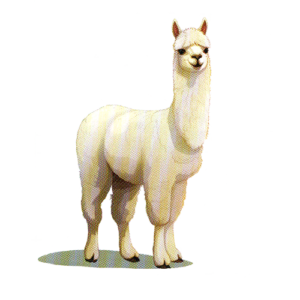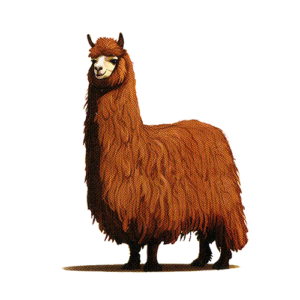All about Alpaca’s
Alpacas are fascinating animals known for their gentle nature, luxurious fleece, and important role in agriculture, especially in South America. Here’s everything you need to know about these charming creatures:
1. Overview of Alpacas
- Scientific Name: Vicugna pacos
- Family: Camelidae (related to llamas, camels, and vicuñas)
- Lifespan: 15-20 years on average, but can live up to 25 years.
- Size: Adult alpacas stand around 3 feet (90 cm) at the shoulder and can reach up to 5 feet (1.5 meters) in height to the top of their head.
- Weight: They usually weigh between 120-190 pounds (55-85 kg).
2. Origin and Habitat
- Native Region: Alpacas are native to the Andean mountains of South America, particularly in Peru, Bolivia, and Chile. They thrive in high-altitude regions between 10,000 and 14,000 feet (3,000-4,300 meters) above sea level.
- Domestication: They were domesticated around 6,000 years ago by the ancient civilizations of the Andes, mainly for their valuable fiber.
3. Types of Alpacas
There are two distinct breeds of alpacas:
-
-
-
Huacaya:
-

This is the most common breed, with about 90% of all alpacas belonging to this type. They have fluffy, crimped fleece that looks like a teddy bear’s fur, making their fiber bouncy and soft.-
-
Suri:

-
The Suri alpaca has long, silky, and lustrous fleece that hangs down in distinctive pencil-like locks. Their fiber is smoother and shinier, often compared to silk.
Differences Between Huacaya and Suri Alpacas
Feature Huacaya Alpacas Suri Alpacas Fleece Type Fluffy, crimped, and bouncy Silky, straight, and shiny Appearance Teddy bear-like, rounded face Elegant, with long, pencil-like locks Fleece Production Higher volume due to dense fiber Less volume but more luster Temperament Calm and friendly Slightly more reserved Popularity 90% of all alpacas worldwide 10% of all alpacas worldwide -
4. Alpaca Fiber and Its Benefits
- Hypoallergenic: Alpaca wool is free from lanolin, which makes it less likely to cause allergies compared to sheep’s wool.
- Soft and Luxurious: Alpaca fiber is incredibly soft, often compared to cashmere. It is lightweight yet warm, making it ideal for winter clothing.
- Variety of Colors: Alpacas naturally come in over 22 different colors, from pure white to deep black, including shades of gray, brown, and beige. This variety reduces the need for chemical dyes.
- Durable and Water-Resistant: The fibers are strong and long-lasting, resistant to pilling, and naturally water-repellent, providing excellent insulation even when wet.
- Eco-Friendly: Alpacas are gentle on the environment. They have padded feet instead of hooves, which minimizes soil damage, and their efficient grazing habits help preserve pastures.
5. Behavior and Temperament
- Gentle Nature: Alpacas are known for their friendly and curious temperament. They are social herd animals that prefer the company of other alpacas.
- Communication: They communicate through body language and soft humming sounds. When threatened or annoyed, they may spit, although this is more common among themselves than towards humans.
- Intelligence: Alpacas are quite intelligent, able to recognize their caretakers, and can even be trained to walk on a leash.
6. Alpaca Farming and Uses
- Farming: Alpacas are primarily raised for their fiber, which is shorn annually. One alpaca can produce 5-10 pounds (2.3-4.5 kg) of fiber each year.
- Guard Animals: Due to their protective instincts, alpacas are sometimes used to guard livestock like sheep and goats from predators.
- Companionship: They are increasingly popular as companion animals and can be found on hobby farms around the world due to their manageable size and calm demeanor.
7. Health and Care
- Diet: Alpacas are herbivores, primarily grazing on grasses. They have a three-compartment stomach that efficiently digests food, making them low-maintenance in terms of feeding.
- Healthcare: They are generally hardy animals but require routine care, including vaccinations, worming, and regular toenail trimming. Dental care is also important since their teeth grow continuously.
- Shearing: Alpacas are sheared once a year, usually in spring, to prevent them from overheating in warmer months.
8. Alpacas vs. Llamas
While alpacas and llamas are closely related, there are a few key differences:
- Size: Llamas are larger and can carry heavy loads, while alpacas are smaller and are bred primarily for their fiber.
- Ears: Alpacas have short, spear-shaped ears, while llamas have longer, banana-shaped ears.
- Temperament: Alpacas are generally more docile, whereas llamas can be more independent and are often used as pack animals.
9. Cultural Significance
- Inca Civilization: Alpacas were highly valued by the ancient Inca civilization, with their fleece considered so luxurious that it was reserved for royalty.
- Modern Day: Today, alpaca fiber is sought after worldwide for high-quality textiles, including sweaters, scarves, blankets, and more.
10. Fun Facts about Alpacas
- Alpaca Yoga: Similar to goat yoga, alpaca yoga has become a popular activity, where participants practice yoga in the presence of alpacas for a relaxing and fun experience.
- Colorful Names: Baby alpacas are called “crias,” and a group of alpacas is known as a “herd” or “flock.”
- Spitting: While they can spit to show displeasure, it’s usually aimed at other alpacas, not humans.
Alpacas are truly remarkable animals, offering a sustainable and eco-friendly option for high-quality fibers while also bringing joy to those who raise and interact with them.
